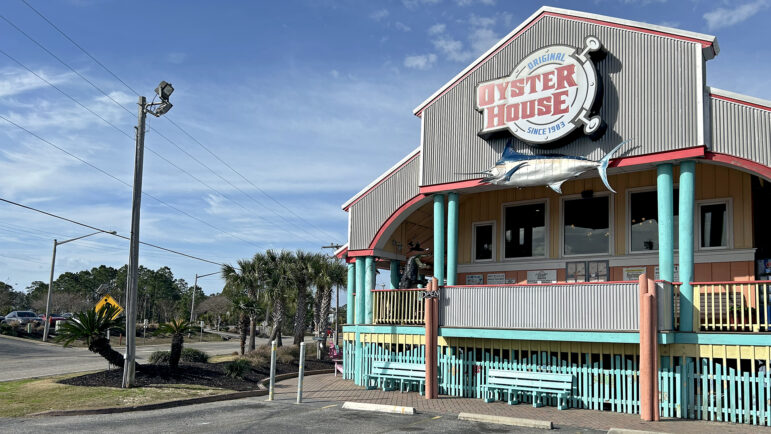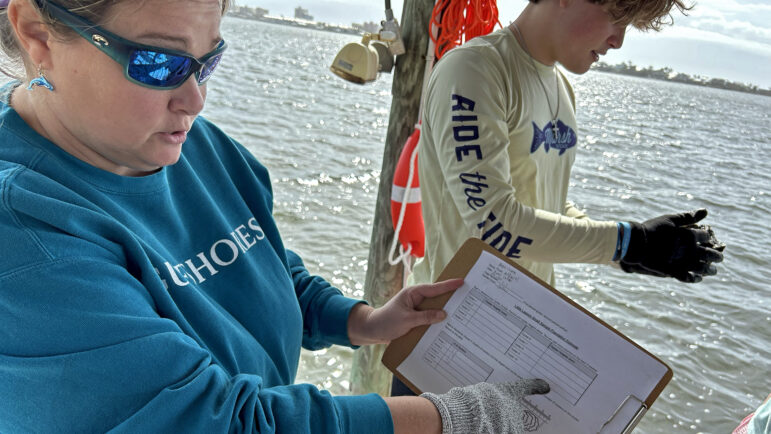From sea to table to sea: How recycled oyster shells are restoring the Alabama coast
A Gulf Shores High School student counts the number of oysters in a cluster at the Little Lagoon Preservation Society’s oyster gardens in Gulf Shores, Alabama, on Feb. 9, 2024. These oysters are part of oyster gardening efforts in Alabama and Mississippi.
It’s lunchtime at the Original Oyster House in Gulf Shores, Alabama, and Jeremy Sullivan is digging into a plate of delectable mollusks — literally.
Rather than eating them straight out of the shell, he uses a fork to scoop his oysters out and drops them quietly into his mouth.
Cecilia Mace, the restaurant’s marketing director, stands nearby and is not having it. She offers Sullivan some advice to make the experience more enjoyable.
“Pick up the shell and suck it out of there,” Mace says while laughing.
Sullivan agrees, and the resulting slurp is worth the effort.

When Sullivan finishes his order, his discarded shells will go into a container separate from the restaurant’s other trash. That’s because instead of ending up in a trash heap, they’ll soon find a second life through the Alabama Coastal Foundation‘s (ACF) Oyster Shell Recycling Program.
The program cleans up the shells and tosses them back into the nearby ocean to help rebuild Alabama’s coastline.
Mace said the Original Oyster House was one of the first restaurants to pilot the program. Before the program launched in 2016, the state paid millions to buy back oyster shells. Mark Berte, the executive director of the ACF, said the program was decades in the making before a grant from the National Fish and Wildlife Foundation helped make it a reality.
“Most restaurants are putting them in their dumpster and they’re putting them in a landfill, and these oyster shells are like gold,” Mace said.

There’s a good reason to want these old shells. Oyster reefs on Alabama’s coast, like many others in the Gulf South, have taken a beating from climate change. Returning these shells to the water helps more oysters grow in their place to play an important role in their ecosystem. They filter and improve the water quality, give a home to fish, crabs, and other animals and help with erosion by providing natural protection to the shoreline.
Since starting the program, the ACF has collected over 22.6 million shells, covering over 57 acres of land. The foundation modeled its recycling program after similar projects in other regions, like New Orleans. Initially, it started with restaurants in Mobile and Baldwin counties, but now it’s statewide.
‘Smells like progress’

The way that the recycling program works is simple: restaurants put their old shells in containers separate from any other trash. Then, anywhere from once to a few times a week, a company contracted by the state coastal foundation will collect them and take those shells to a curing site on state property.
That process can take a while since the shells must be cured before returning to the water. Walking through the oyster fields, you see piles of shells everywhere.
“It’s much like managing a compost pile,” P. J. Waters, an associate extension professor at Auburn University who is on the advisory committee for the recycling program, said. “We have to get all the soft tissue off and the butter and the cheese, or whatever else that may be on it, to be degraded.”
Waters said this process can take six months to a year before the shells are finally ready to return to the water. In the meantime, you have shells covered in material in varying states of decay, leading to a terrible, but promising, smell.
“Tell folks I said it smells like progress,” Waters said.

After they’ve cured, some of the shells are used in another program designed to help the oyster populations increase — oyster gardening. Waters coordinates the oyster gardening programs in Alabama and Mississippi.
These shells are reset with baby oysters, which like to attach to another surface to grow, before heading off to the garden.
Waters said these efforts are especially important in the northern Gulf Coast because it’s one of the last places in the world where restoration can work. Globally, about 85% of oyster reefs have been lost.
Encouraging the next generation

The oysters in the gardening program aren’t for consumption, which Waters said isn’t usually a problem for volunteers.
The Original Oyster House has its own oyster garden in Little Lagoon, which is along the Gulf Shores coast. On the other side of the lagoon, the Little Lagoon Preservation Society also manages its own gardens. Dennis Hatfield, the society’s president, said they get the oysters delivered to them by Waters and Auburn University prior to the start of the Alabama gardening season, which is usually in June.
The oysters are put in cages and maintained until the end of the season, which is usually late October or early November. Then, they are harvested and taken to Mobile Bay to be put on closed public reefs, Hatfield said.
The preservation society is still growing oysters in February for Mississippi, which runs on a different growing season, with some help from Gulf Shores High School students.
Krista Fleming, an environmental science teacher at the high school, said she brings her students to the lagoon to teach them about the preservation effort and to estimate how many oysters they have. Oysters tend to grow in clusters, so students count how many individual oysters there are by hand.
“The students actually calculate the ecosystem services that oysters provide, such as filtration, habitat, those types of things,” Fleming said.

But while it’s educational, it’s also serving as a way to encourage a younger generation to get excited about doing something good for the environment.
“[The students] were upbeat about this,” Hatfield said. “The feedback I get from Krista is that they love coming out here.”
Eventually, these oysters will make it back into the ecosystem, helping to rebuild the oyster reef along the Gulf Coast — one project at a time.
This story was produced by the Gulf States Newsroom, a collaboration between Mississippi Public Broadcasting, WBHM in Alabama, WWNO and WRKF in Louisiana and NPR.
Supreme Court allows Trump to resume mass federal layoffs for now
Justice Ketanji Brown Jackson, who was appointed to the court by President Biden, dissented.
Graphics: Where the Texas floods happened and how high the waters rose
One Guadalupe River gauge near Kerrville and Camp Mystic recorded a rise of more than 25 feet in two hours.
Haiti’s iconic Hotel Oloffson, long a cultural beacon, destroyed by gang violence
The Hotel Oloffson in Haiti's capital Port-au-Prince, long a haven for artists and writers, poets and presidents, a symbol of Haiti's troubled politics and its storied past, has been destroyed by gangs.
New books this week focus on Caitlin Clark, King Tut, and how ‘Democrats Lost America’
Plus: a new novel from Gary Shteyngart, a true story of a shipwreck, and a memoir from a wrongly incarcerated inmate who was exonerated after 28 years behind bars.
Shoes off at the airport? TSA appears to be giving the pesky rule the boot
For nearly twenty years, most air travelers in the U.S. have been required to remove their shoes when going through security. That requirement seems to be ending.
Texas flood recovery efforts face tough conditions as local officials face hard questions
Emergency responders kept hope alive as they combed through fallen trees and other debris that littered the hard-hit central Texas communities on the fifth day after devastating floods killed more than 100.








